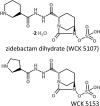WCK 5107 (Zidebactam) and WCK 5153 Are Novel Inhibitors of PBP2 Showing Potent "β-Lactam Enhancer" Activity against Pseudomonas aeruginosa, Including Multidrug-Resistant Metallo-β-Lactamase-Producing High-Risk Clones
- PMID: 28289035
- PMCID: PMC5444176
- DOI: 10.1128/AAC.02529-16
WCK 5107 (Zidebactam) and WCK 5153 Are Novel Inhibitors of PBP2 Showing Potent "β-Lactam Enhancer" Activity against Pseudomonas aeruginosa, Including Multidrug-Resistant Metallo-β-Lactamase-Producing High-Risk Clones
Abstract
Zidebactam and WCK 5153 are novel β-lactam enhancers that are bicyclo-acyl hydrazides (BCH), derivatives of the diazabicyclooctane (DBO) scaffold, targeted for the treatment of serious infections caused by highly drug-resistant Gram-negative pathogens. In this study, we determined the penicillin-binding protein (PBP) inhibition profiles and the antimicrobial activities of zidebactam and WCK 5153 against Pseudomonas aeruginosa, including multidrug-resistant (MDR) metallo-β-lactamase (MBL)-producing high-risk clones. MIC determinations and time-kill assays were conducted for zidebactam, WCK 5153, and antipseudomonal β-lactams using wild-type PAO1, MexAB-OprM-hyperproducing (mexR), porin-deficient (oprD), and AmpC-hyperproducing (dacB) derivatives of PAO1, and MBL-expressing clinical strains ST175 (blaVIM-2) and ST111 (blaVIM-1). Furthermore, steady-state kinetics was used to assess the inhibitory potential of these compounds against the purified VIM-2 MBL. Zidebactam and WCK 5153 showed specific PBP2 inhibition and did not inhibit VIM-2 (apparent Ki [Kiapp] > 100 μM). MICs for zidebactam and WCK 5153 ranged from 2 to 32 μg/ml (amdinocillin MICs > 32 μg/ml). Time-kill assays revealed bactericidal activity of zidebactam and WCK 5153. LIVE-DEAD staining further supported the bactericidal activity of both compounds, showing spheroplast formation. Fixed concentrations (4 or 8 μg/ml) of zidebactam and WCK 5153 restored susceptibility to all of the tested β-lactams for each of the P. aeruginosa mutant strains. Likewise, antipseudomonal β-lactams (CLSI breakpoints), in combination with 4 or 8 μg/ml of zidebactam or WCK 5153, resulted in enhanced killing. Certain combinations determined full bacterial eradication, even with MDR MBL-producing high-risk clones. β-Lactam-WCK enhancer combinations represent a promising β-lactam "enhancer-based" approach to treat MDR P. aeruginosa infections, bypassing the need for MBL inhibition.
Keywords: Gram-negative bacteria; PBP2 inhibition; Pseudomonas aeruginosa; WCK 5107; WCK 5153; bicyclo-acyl hydrazide; penicillin-binding proteins; time-kill curves; zidebactam; β-lactam enhancer.
Copyright © 2017 American Society for Microbiology.
Figures







Similar articles
-
Potent β-Lactam Enhancer Activity of Zidebactam and WCK 5153 against Acinetobacter baumannii, Including Carbapenemase-Producing Clinical Isolates.Antimicrob Agents Chemother. 2017 Oct 24;61(11):e01238-17. doi: 10.1128/AAC.01238-17. Print 2017 Nov. Antimicrob Agents Chemother. 2017. PMID: 28848013 Free PMC article.
-
In Vitro and In Vivo Activities of β-Lactams in Combination with the Novel β-Lactam Enhancers Zidebactam and WCK 5153 against Multidrug-Resistant Metallo-β-Lactamase-Producing Klebsiella pneumoniae.Antimicrob Agents Chemother. 2019 Apr 25;63(5):e00128-19. doi: 10.1128/AAC.00128-19. Print 2019 May. Antimicrob Agents Chemother. 2019. PMID: 30782985 Free PMC article.
-
Structural Characterization of Diazabicyclooctane β-Lactam "Enhancers" in Complex with Penicillin-Binding Proteins PBP2 and PBP3 of Pseudomonas aeruginosa.mBio. 2021 Feb 16;12(1):e03058-20. doi: 10.1128/mBio.03058-20. mBio. 2021. PMID: 33593978 Free PMC article.
-
New Drugs for Multidrug-Resistant Gram-Negative Organisms: Time for Stewardship.Drugs. 2019 May;79(7):705-714. doi: 10.1007/s40265-019-01112-1. Drugs. 2019. PMID: 30972660 Review.
-
New β-Lactam-β-Lactamase Inhibitor Combinations.Clin Microbiol Rev. 2020 Nov 11;34(1):e00115-20. doi: 10.1128/CMR.00115-20. Print 2020 Dec 16. Clin Microbiol Rev. 2020. PMID: 33177185 Free PMC article. Review.
Cited by
-
Penicillin-binding protein (PBP) inhibitor development: A 10-year chemical perspective.Exp Biol Med (Maywood). 2023 Oct;248(19):1657-1670. doi: 10.1177/15353702231208407. Epub 2023 Nov 29. Exp Biol Med (Maywood). 2023. PMID: 38030964 Free PMC article. Review.
-
Is it time to move away from polymyxins?: evidence and alternatives.Eur J Clin Microbiol Infect Dis. 2021 Mar;40(3):461-475. doi: 10.1007/s10096-020-04053-w. Epub 2020 Oct 2. Eur J Clin Microbiol Infect Dis. 2021. PMID: 33009595 Review.
-
Impact of chromosomally encoded resistance mechanisms and transferable β-lactamases on the activity of cefiderocol and innovative β-lactam/β-lactamase inhibitor combinations against Pseudomonas aeruginosa.J Antimicrob Chemother. 2024 Oct 1;79(10):2591-2597. doi: 10.1093/jac/dkae263. J Antimicrob Chemother. 2024. PMID: 39073766 Free PMC article.
-
The Novel β-Lactam Enhancer Zidebactam Augments the In Vivo Pharmacodynamic Activity of Cefepime in a Neutropenic Mouse Lung Acinetobacter baumannii Infection Model.Antimicrob Agents Chemother. 2019 Mar 27;63(4):e02146-18. doi: 10.1128/AAC.02146-18. Print 2019 Apr. Antimicrob Agents Chemother. 2019. PMID: 30670419 Free PMC article.
-
Targeting Multidrug-Resistant Acinetobacter spp.: Sulbactam and the Diazabicyclooctenone β-Lactamase Inhibitor ETX2514 as a Novel Therapeutic Agent.mBio. 2019 Mar 12;10(2):e00159-19. doi: 10.1128/mBio.00159-19. mBio. 2019. PMID: 30862744 Free PMC article.
References
MeSH terms
Substances
Grants and funding
LinkOut - more resources
Full Text Sources
Other Literature Sources
Research Materials
Miscellaneous

